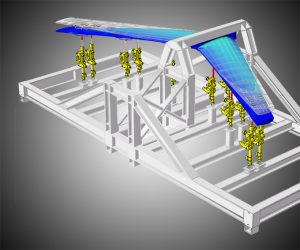The resilience and stress resistance of aircraft components are significant factors in the granting of airworthiness certificates for new aircraft types. NLR carried out essential tests on components for the American Gulfstream G650 business jet.
The NLR tests focused specifically on the T-tail; the stabiliser and elevator. The tail is built by Fokker. The stabiliser and elevator are hybrid constructions, with an aluminium internal structure and an outer shell made of composites. Both aircraft components were subjected to extensive tests that measured the strength of the new structural elements and their stress resistance, both before and after they had undergone deliberate damage. For a period of six months, the tailplane was set in motion by 18 hydraulic cylinders adjusted to simulate physical flight conditions. The effects of the exerted forces were monitored by 500 displacement transducers and strain gauges along several meters of the component’s surface, as well as by an advanced optical monitoring system. The test rig for the smaller elevator component had a higher degree of complexity. This part is mounted in the tailplane and must therefore be capable of following the tailplane’s enforced displacement. That extra dimension was also incorporated in a test rig and a representative test period.
The success of the tests was largely dependent on the accuracy of predictive calculations and the extent to which test results could be directly compared with these predictions. The NLR tests confirmed that the tail components were indeed capable of resisting lengthy exposure to severe loads and were safe to use even after being seriously damaged. These tests marked a milestone for the G650 as they led to the granting of a provisional airworthiness certificate and paved the way for further development by way of test flights.
The NLR tests confirmed that the tail components were indeed capable of resisting lengthy exposure to severe loads and were safe to use even after being seriously damaged

